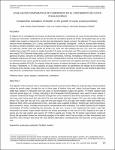Mostrar el registro sencillo del ítem
Evaluación comparativa de comederos en el crecimiento de cuyes (Cavia porcellus)
| dc.contributor.author | Sarria Bardales, José Antonio | |
| dc.contributor.author | Cantaro Segura, Jose Luis | |
| dc.contributor.author | Mosqueira Robles, Alexandra | |
| dc.date.accessioned | 2021-11-05T23:10:30Z | |
| dc.date.available | 2021-11-05T23:10:30Z | |
| dc.date.issued | 2020 | |
| dc.identifier.citation | Sarria Bardales, José Antonio, Cantaro Segura, Jose Luis, & Mosqueira Robles, Alexandra. (2020). Evaluación comparativa de comederos en el crecimiento de cuyes (Cavia porcellus). Revista de Investigación e Innovación Agropecuaria y de Recursos Naturales, 7(1), 79-87. Recuperado en 04 de noviembre de 2021, de http://www.scielo.org.bo/scielo.php?script=sci_arttext&pid=S2409-16182020000100011&lng=es&tlng=es. | es_PE |
| dc.identifier.uri | https://hdl.handle.net/20.500.12996/5018 | |
| dc.description | Universidad Nacional Agraria La Molina. Escuela de Posgrado. Maestría en Producción Animal | es_PE |
| dc.description.abstract | El objetivo de la investigación fue evaluar la eficiencia productiva y económica de cuyes (Cavia porcellus) durante la etapa de crecimiento, mediante el uso de tres tipos de comederos (pocillo de arcilla, tolva plástica tipo ave y tolva metálica tipo conejo) en interacción con dos tipos de alojamiento (jaulas y pozas). Se utilizaron 72 cuyes mejorados machos recién destetados (14 ± 3 días), pertenecientes al genotipo Cieneguilla - UNALM, durante siete semanas. Se utilizó un diseño completo al azar con arreglo factorial de seis tratamientos y tres repeticiones de cuatro animales en cada una; siendo: poza con pocillo de arcilla (T1), poza con tolva plástica tipo ave (T2), poza con comedero metálico tipo conejo (T3), jaula con pocillo de arcilla (T4), jaula con tolva tipo ave (T5) y jaula con comedero metálico tipo conejo (T6). El alimento balanceado, que fue integral en harina, y el agua se suministraron ad libitum. Se evaluó ganancia de peso, consumo de alimento, conversión alimenticia, mermas, mortalidad y retribución económico. Los resultados indican que, el mayor consumo (P<0.05), considerando la merma, como parte del mismo, se presenta en los tratamientos que usaron pocillo de arcilla; entre tanto el comedero tipo tolva plástica permitió el menor porcentaje de alimento perdido (P<0.05). En relación al tipo de cuyera, el sistema de jaulas fue superior (P<0.05) en ganancia de peso. Finalmente, el T5 (tolva plástica en jaula) evidenció tener los parámetros por debajo de los promedios numéricos de los demás, lo que repercutió en su retribución y mérito económico, siendo en este sentido la alternativa más eficiente; considerando únicamente el rubro alimentación como el costo productivo. | es_PE |
| dc.description.abstract | The objective of the research was to evaluate the productive and economic efficiency of guinea pigs (Cavia porcellus) during the growth stage, through the use of three types of feeders (clay well, plastic bird-type hopper and metal rabbit-type hopper) in interaction with two types of accommodation (cages and pools). 72 freshly weaned male improved guinea pigs (14 ± 3 days), belonging to the Cieneguilla-UNALM genotype, were used for seven weeks. A complete randomized design with factorial arrangement of six treatments and three replications of four animals in each was used; being: pool with clay well (T1), pool with plastic bird-type hopper (T2), pool with metal rabbit-type feeder (T3), cage with clay well (T4), cage with bird-type hopper (T5) and cage with metallic rabbit type feeder (T6). Balanced feed, which was wholemeal in flour, and water were supplied ad libitum. Weight gain, feed consumption, feed conversion, losses, mortality and economic compensation were evaluated. The results indicate that the highest consumption (P<0.05), considering the decrease, as part of it, occurs in the treatments that used a clay well; meanwhile the plastic hopper feeder allowed the lowest percentage of lost food (P<0.05). Regarding the type of guinea pig, the cage system was superior (P <0.05) in weight gain. Finally, the T5 (plastic cage hopper) evidenced having the parameters below the numerical averages of the others, which had an impact on their remuneration and economic merit, being in this sense the most efficient alternative; considering only the food item as the productive cost | en_US |
| dc.format | application/pdf | en_US |
| dc.language.iso | spa | es_PE |
| dc.publisher | Universidad Mayor de San Andrés, Facultad de Agronomía, Instituto de Investigaciones Agropecuarias y de Recursos Naturales | es_PE |
| dc.rights | info:eu-repo/semantics/openAccess | en_US |
| dc.source | http://www.scielo.org.bo/scielo.php?pid=S2409-16182020000100011&script=sci_abstract | es_PE |
| dc.subject | Cobaya | es_PE |
| dc.subject | Cobaya | es_PE |
| dc.subject | Alimentación de los animales | es_PE |
| dc.subject | Crecimiento | es_PE |
| dc.subject | Engorde | es_PE |
| dc.subject | Ganancia de peso | es_PE |
| dc.subject | Forraje verde | es_PE |
| dc.subject | Suministro de alimentos | es_PE |
| dc.subject | Piensos | es_PE |
| dc.subject | Caracteres de rendimiento | es_PE |
| dc.subject | Periodo de crecimiento | es_PE |
| dc.subject | Rentabilidad | es_PE |
| dc.subject | Evaluación | es_PE |
| dc.subject | Perú | es_PE |
| dc.subject | Cavia porcellus | es_PE |
| dc.subject | Cuyes | es_PE |
| dc.subject | Programas de alimentación para animales | es_PE |
| dc.title | Evaluación comparativa de comederos en el crecimiento de cuyes (Cavia porcellus) | es_PE |
| dc.title.alternative | Comparative evaluation of feeders in the growth of cuyes (Cavia porcellus) | en_US |
| dc.type | info:eu-repo/semantics/article | en_US |
| dc.subject.ocde | https://purl.org/pe-repo/ocde/ford#4.02.01 | es_PE |
| dc.publisher.country | BO | es_PE |
| dc.type.version | info:eu-repo/semantics/publishedVersion | en_US |


